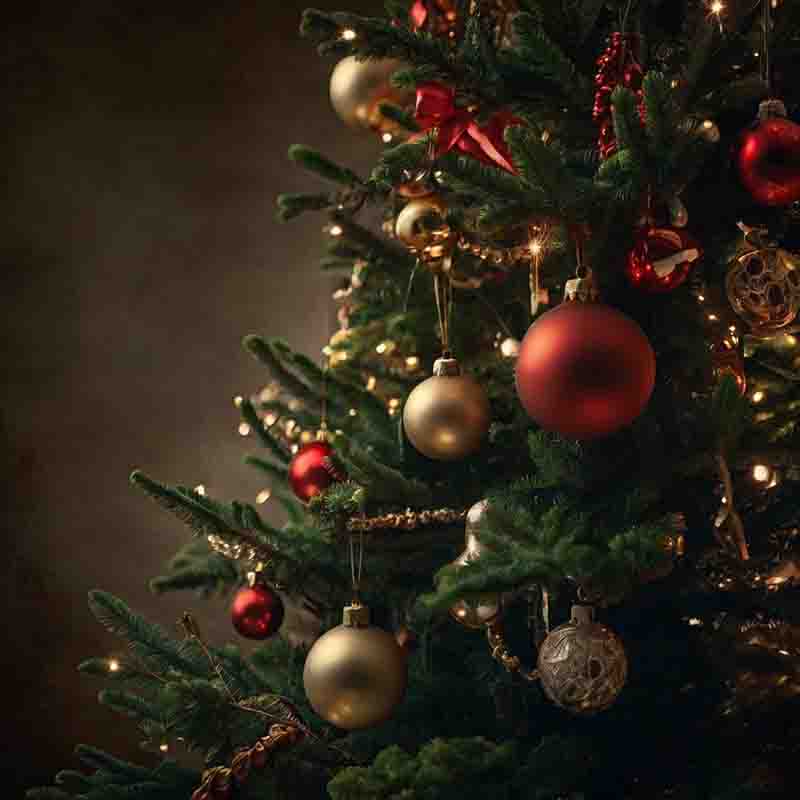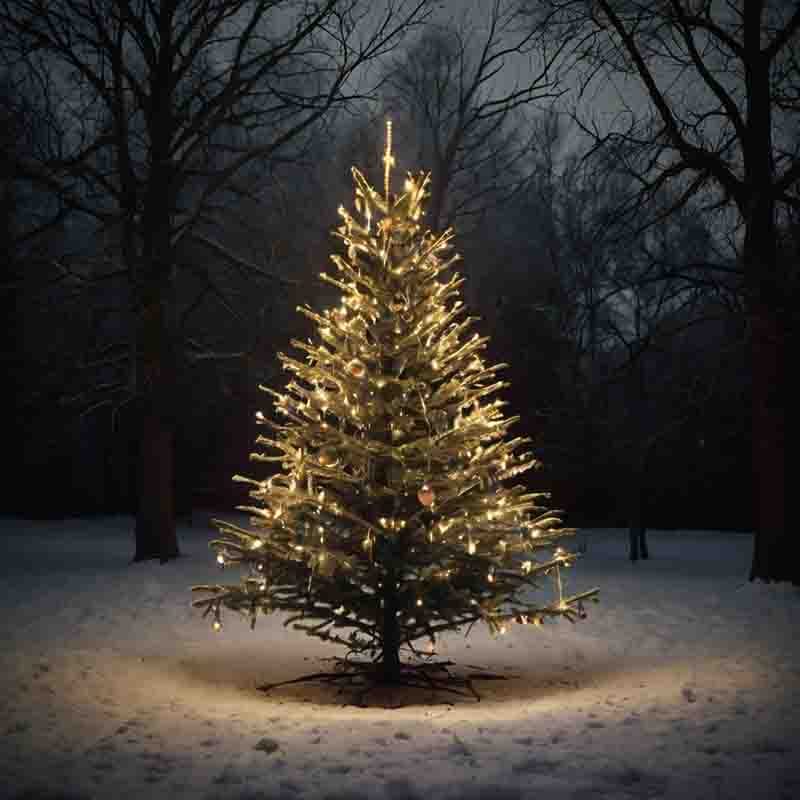The Origins of Christmas
Christmas is a widely celebrated holiday observed on December 25th. It commemorates the birth of Jesus Christ and carries deep religious and cultural significance.

Whether observing its spiritual roots or embracing modern festivities, people find connection and joy during Christmas time.
Christmas Traditions
-
Nativity Scenes: These depict the birth of Jesus, often featuring Mary, Joseph, and the infant Christ, alongside shepherds, angels, and the Wise Men.
-
Christmas Trees: Originating in Germany, decorated evergreen trees became popular in the 16th century and spread globally.
-
Gift-Giving: Inspired by the biblical Magi and St. Nicholas, this tradition emphasizes generosity and goodwill.
-
Caroling: Singing festive songs has roots in both sacred hymns and secular folk music.
The origins of Christmas date back to early Christianity.
The date was chosen in part to coincide with Roman winter solstice festivals, such as Saturnalia, and the celebration of Sol Invictus.
The holiday grew in importance during the Middle Ages, incorporating local folk traditions, caroling, and feasting.
Today, Christmas is celebrated in diverse ways around the world.
In addition to religious observances, people gather for family meals, decorate their homes, exchange gifts, and enjoy festive entertainment.
Iconic figures like Santa Claus, derived from St. Nicholas and Nordic folklore, play a central role in spreading holiday cheer.
Christmas has inspired countless works of art, music, and literature.
From Charles Dickens' A Christmas Carol to timeless carols like "Silent Night," its influence is undeniable.
Christmas is a time for reflection, joy, and togetherness. Its mix of historical depth, religious meaning, and festive customs makes it one of the most beloved celebrations worldwide.
12 Facts To Know About Christmas
-
Date and Origin: Christmas is celebrated on December 25th, commemorating the birth of Jesus Christ. The date was established in the 4th century to align with Roman festivals like Saturnalia.
-
Religious Significance: For Christians, Christmas honors the Nativity of Jesus as a pivotal moment in theology, symbolizing hope, peace, and salvation.
-
Global Celebration: Christmas is celebrated worldwide, blending Christian traditions with local customs. It is both a religious and cultural holiday in many countries.
-
The Advent Season: Advent marks the four weeks leading up to Christmas, symbolizing anticipation and preparation for the birth of Christ.
-
Christmas Tree Tradition: The Christmas tree originated in Germany during the 16th century. It represents life and renewal, adorned with ornaments, lights, and a star or angel on top.
-
Santa Claus: Santa Claus, inspired by St. Nicholas, evolved into the modern figure of a gift-giving icon. His image is a blend of European folklore and 19th-century American marketing.
-
Gift-Giving: Exchanging gifts reflects the story of the Magi presenting gifts to Jesus and is a symbol of generosity and thoughtfulness during the season.
-
Music and Carols: Christmas carols, like "Silent Night" and "Jingle Bells," are integral to the holiday spirit. They range from religious hymns to festive secular songs.
-
Feasting and Special Foods: Traditional Christmas foods vary by region, including turkey, ham, mince pies, gingerbread, stollen, and panettone. These meals often bring families together.
-
Nativity Scenes: Depicting the birth of Jesus, nativity scenes include figures like Mary, Joseph, the infant Jesus, shepherds, angels, and the Wise Men.
-
Holiday Decorations: Decorations such as wreaths, mistletoe, and candles enhance the festive atmosphere. Public spaces often feature grand displays and light shows.
-
Cultural Impact: Christmas has inspired iconic literature (A Christmas Carol), movies (It’s a Wonderful Life), and songs that reinforce themes of generosity, family, and joy.
These facts provide a comprehensive understanding of Christmas, highlighting its significance, traditions, and cultural impact.
Christmas Timeline
| Time Period | Description |
|---|---|
| 4th Century AD | The first recorded celebration of Christmas on December 25th as the birth of Jesus in the Roman Empire. |
| 5th Century | Christmas recognized as an official Christian festival. |
| 12th Century | Christmas becomes a more prominent feast in medieval Europe. |
| 16th Century | The Protestant Reformation influences Christmas celebrations in Europe. |
| 17th Century | Puritans in England and America disapprove of Christmas celebrations. |
| 19th Century | The Victorian era sees a revival of Christmas traditions and the popularization of the Christmas tree. |
| 1823 | "A Visit from St. Nicholas" (commonly known as "The Night Before Christmas") is published. |
| 1843 | Charles Dickens publishes "A Christmas Carol," contributing to the modern Christmas spirit. |
| 1870 | Christmas is declared a federal holiday in the United States. |
| 1931 | Coca-Cola popularizes the modern image of Santa Claus through its advertising. |
| 1941 | Irving Berlin writes "White Christmas," becoming one of the best-selling songs of all time. |
| 1965 | "A Charlie Brown Christmas" airs, becoming a holiday classic. |
| 1970s | Commercialization of Christmas accelerates with the rise of consumerism. |
| 1984 | "Do They Know It's Christmas?", a charity song written in 1984 raised money for the hunger famine in Ethiopia in 1983-1985. |
| 2000s | Despite the emergence of the Internet, Christmas cards are still being sent by regular mail |
| Present | Christmas continues to be a popular holiday, although for some people it is a preference to proclaim "Happy Holidays" instead of "Merry Christmas". |
This timeline outlines the evolution of Christmas from its religious roots to the widespread secular and commercial holiday we know today.
Christmas: Light Up the Night

Christmas embodies the spirit of joy, affection and togetherness. Whether through the extensive range of traditions, the symbolism of colors and decorations or the influence of marketing and modern celebrations, Christmas remains a vibrant and precious time of year.
Christmas: Season of Joy and Togetherness
Christmas is a time to reflect on the teachings of Jesus, which emphasize love, kindness, and peace.
The story of his birth in Bethlehem is central to Christian observance, often depicted in nativity scenes and retold through church services and songs.
For Christians, Christmas is a time to celebrate the arrival of the Savior, who brought a message of hope and redemption to the world.
Over time, Christmas has also become a secular holiday, embraced by people of various faiths and cultures.
Many observe Christmas as a time to spend with family and friends, exchange gifts, and engage in festive activities such as decorating homes and trees, enjoying holiday meals, and singing Christmas carols.
The History of Christmas
Christmas traces its origins back to ancient Rome.
Early Christians, seeking a date for the birth of Jesus Christ, chose December 25th to coincide with existing pagan festivals, such as Saturnalia, which celebrated the winter solstice.
Over the centuries, Christmas morphed from a religious observance into a larger cultural celebration, influenced by customs from all over the world.
In the Middle Ages, Christmas became more of a religious observance.
People gathered in churches to mark the birth of Jesus Christ.
The nativity scene, which tells the story of Jesus' birth, became a central symbol of the season.
By the 16th century, the tradition of decorating trees, exchanging gifts, and celebrating with family began to take root in Europe, particularly in Germany.
As the centuries passed, Christmas spread across the globe, with various cultures adding their own unique customs.
Today, Christmas is celebrated not just by Christians but by people of all backgrounds, often focusing on universal themes of family, goodwill, and kindness.
Religious Observances
Christians around the world celebrate the birth of Jesus Christ.
Many participate in Midnight Mass on Christmas Eve or attend church services on Christmas Day.
These services include hymns, readings from the Bible, and prayers.
One of the most beloved customs is the Nativity scene, which portrays the birth of Jesus with figures such as Mary, Joseph, and the infant Jesus, surrounded by animals, angels, and the three Wise Men.
Another important religious observance is Advent, the four-week period leading up to Christmas.
Advent calendars, with their daily windows to open, provide a fun way to count down the days until Christmas.
Advent wreaths, featuring four candles, are another common practice, with one candle lit each Sunday leading to Christmas Eve.
Decorations and Symbols
Christmas decorations vary widely around the world, but there are some common elements.
One of the most iconic symbols of Christmas is the Christmas tree.
Originating in Germany in the 16th century, the Christmas tree was initially decorated with edible items like apples and nuts.
Over time, it became adorned with candles and ornaments, and it now serves as the focal point of many homes during the season.
Lights are another significant part of Christmas decorations.
From the simple strands of twinkling lights in homes to large, elaborate displays in cities, Christmas lights bring an extra layer of magic to the season.
The use of candles, both on trees and in homes, symbolizes the light of Christ entering the world.
Other symbols of Christmas include holly, mistletoe, and wreaths.
Holly, with its evergreen leaves, represents eternal life, while mistletoe is linked to an ancient belief in its power to bring good luck and encourage peace.
Wreaths, often hung on doors, are another sign of hope and rebirth.
Gift-Giving
The practice of giving gifts is one of the most widely recognized aspects of Christmas.
Rooted in the biblical story of the Three Wise Men, who brought gifts to the infant Jesus, gift-giving has become a way to express love, appreciation, and goodwill during the holiday season.
In many cultures, children hang stockings in hopes that Santa Claus will fill them with treats and small toys.
In modern times, gift-giving has expanded to include all members of the family, friends, and even coworkers.
While the types of gifts given vary, the sentiment behind them remains the same: spreading joy and making others feel loved and valued.
Traditional Christmas Dishes
Food plays a major role in Christmas celebrations.
Different regions have their own holiday favorites.
In the United States and the UK, roast turkey is a common centerpiece for the Christmas meal, often accompanied by stuffing, mashed potatoes, vegetables, and gravy.
In Italy, Christmas meals typically include pasta dishes, roasted meats, and a wide array of seafood, especially on Christmas Eve.
Panettone, a sweet bread filled with candied fruits, is a holiday favorite.
Around the world, Christmas is a time to indulge in special foods.
From the rich fruitcakes and mince pies in the UK to the spiced cookies and mulled wine of Scandinavia, food is an integral part of the holiday season.
Sweet Treats and Beverages
Christmas wouldn’t be complete without its sweet treats.
Gingerbread cookies, fruitcake, and Yule log cakes are just a few of the iconic desserts enjoyed at Christmas.
Beverages are equally festive, with eggnog, mulled wine, and hot cocoa warming hearts and hands during the chilly winter months.
In many homes, families make these drinks together, adding a personal touch with ingredients like cinnamon, nutmeg, and cloves.
The Music of Christmas
Christmas carols are an essential part of the holiday experience.
Songs like "Silent Night," "O Holy Night," and "Jingle Bells" set the tone for the season, whether heard during church services, on the radio, or while caroling in the neighborhood.
The tradition of caroling, where groups of people visit homes to sing festive songs, has been around for centuries.
It’s a way of spreading cheer and goodwill, often accompanied by the joy of hot drinks and holiday treats.
In addition to religious hymns, modern Christmas songs have become just as iconic.
Songs like "All I Want for Christmas Is You" and "Last Christmas" have become staples of the holiday season.
Modern Practices and Cultural Impact
Christmas today is influenced by a mix of cultural traditions and commercial interests.
The rise of online shopping, Black Friday sales, and holiday advertising has changed the way people approach gift-giving.
But, despite the commercialization, the core values of kindness, generosity, and family remain at the heart of Christmas celebrations.
Acts of kindness, such as volunteering or donating to charity, have become an important part of the season.
Christmas is a time when people come together to help those in need and show compassion to their fellow human beings.
Christmas Around the World
Christmas is celebrated worldwide, but each country brings its own customs and flavor to the holiday.
In the United States, Christmas is a time for family gatherings, elaborate decorations, and large meals.
In Latin American countries, Christmas is celebrated with festivals, fireworks, and parades. In Mexico, Las Posadas reenacts Mary and Joseph’s search for a place to stay.
Here is a range of varied Christmas traditions:
-
Japan - KFC Christmas Dinner: In Japan, it's a popular tradition to have a Christmas meal from Kentucky Fried Chicken (KFC). Due to a successful marketing campaign in the 1970s, many Japanese families indulge in KFC as a festive treat.
-
Iceland - The Yule Lads: In Iceland, there is a tradition of the Yule Lads, mischievous characters who visit children on the 13 nights leading up to Christmas. Each night, children place a shoe in the window, and the Yule Lads leave small gifts or potatoes, depending on the child's behavior.
-
Ukraine - Spider Webs as Decorations: Ukrainian Christmas trees might feature spider webs as decorations. According to folklore, a poor widow woke up to find her tree covered in cobwebs. When the morning sunlight touched the webs, they turned into gold and silver, bringing fortune to the family.
-
Ethiopia - Ganna, a Unique Christmas Game: In Ethiopia, Christmas is celebrated with a game called Ganna, a traditional hockey-like sport. Families and friends gather to play, creating a festive and communal atmosphere.
-
Venezuela - Roller Skating to Mass: In the capital city of Caracas, it is a tradition for people to roller skate to the early morning Christmas Mass. The streets are closed to cars, and the city comes alive with the sound of church bells and skates.
-
Guatemala - La Quema del Diablo (Burning of the Devil): In Guatemala, people clean their houses thoroughly in the weeks leading up to Christmas. The collected dirt is then used to create effigies of the devil, which are burned on December 7th, symbolizing the cleansing of evil spirits before the holiday.
-
Philippines - Giant Lantern Festival: In the city of San Fernando, locals celebrate the Giant Lantern Festival, showcasing elaborately designed lanterns. The festival has become a major attraction, drawing visitors from around the world.
-
India - Christmas Banana Trees: In southern India, some communities decorate banana or mango trees instead of traditional evergreen trees. The trees are adorned with paper decorations and candles, creating a unique and colorful festive atmosphere.
-
Czech Republic - Predicting the Future: In the Czech Republic, unmarried women stand with their backs to the door on Christmas Eve and throw a shoe over their shoulder. If the toe points towards the door when it lands, it's believed the woman will get married soon.
-
Australia - Beach Celebrations: In Australia, where Christmas falls during the summer, it's common for families to celebrate with a festive picnic or barbecue on the beach. Some even participate in events like the "Carols by Candlelight" concerts held outdoors.
-
Russia - Ded Moroz and Snegurochka: In Russia, Christmas is celebrated on January 7th according to the Julian calendar observed by the Russian Orthodox Church. The celebrations are deeply rooted in religious traditions and are accompanied by unique customs and festivities. A central figure in Russian Christmas celebrations is Ded Moroz (Grandfather Frost), who is accompanied by his granddaughter Snegurochka (Snow Maiden). These characters are akin to Santa Claus and his helper in Western traditions.
These different traditions show how diverse Christmas is celebrated all over the world and give the Christmas season its very own flavor and perspective.
German American Christmas
Christmas is heavily influenced by German traditions. Many aspects of modern Christmas, such as the Christmas tree, Advent calendars and traditional festive German American foods, have their roots in customs first brought to the United States by German immigrants.
The fusion of German and American traditions has created a unique and multifaceted portrayal of Christmas celebrations combining rich immigrant heritage with the expanded American Christmas experience.
Creating Memorable Christmas Moments
Christmas holiday is an annual celebration observed on December 25th, commemorating the birth of Jesus Christ in Christian tradition.
It is celebrated with various activities, such as attending religious services, family gatherings, gift exchanges, and festive meals.
The holiday has also become a time for broader cultural celebrations and commercial festivities, including holiday shopping and public decorations.
Christmas: FAQ
Are you curious about music, art, technology, fashion, lifestyle, and beer?
If so, then you need to subscribe to the free Likewolf newsletter.
100% privacy. When you sign up, we'll keep you posted.

Likewolf's Typewriter
Likewolf writes about music, art, technology, fashion, lifestyle, and beer
LikewolfGerman American Cuisine
The rich culinary heritage of German immigrants